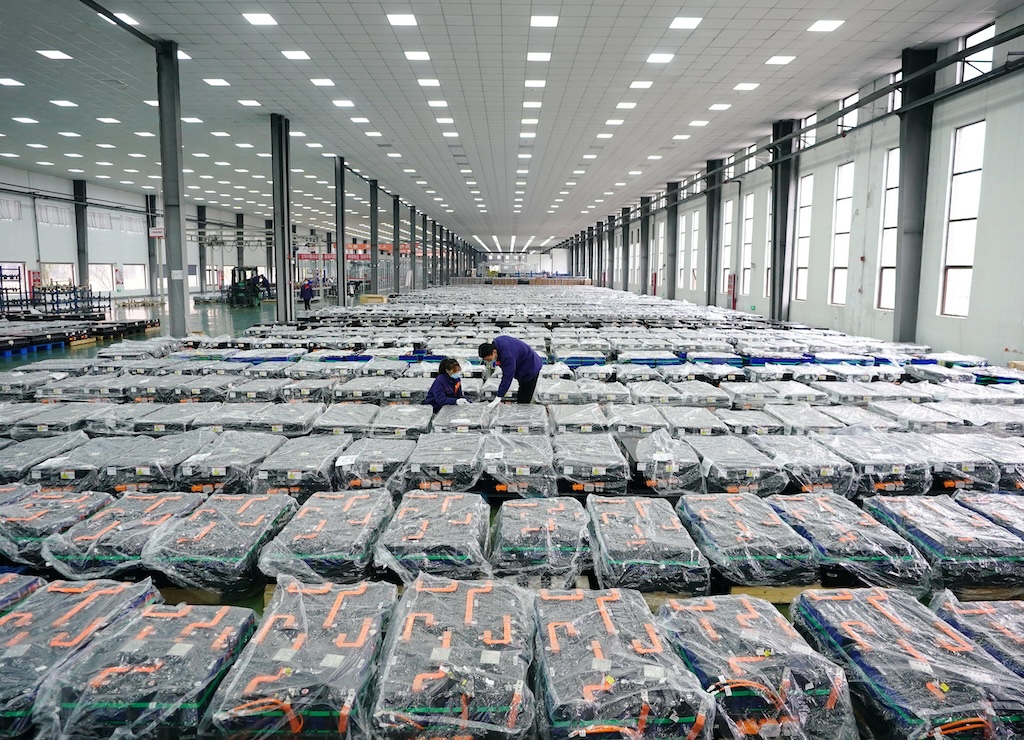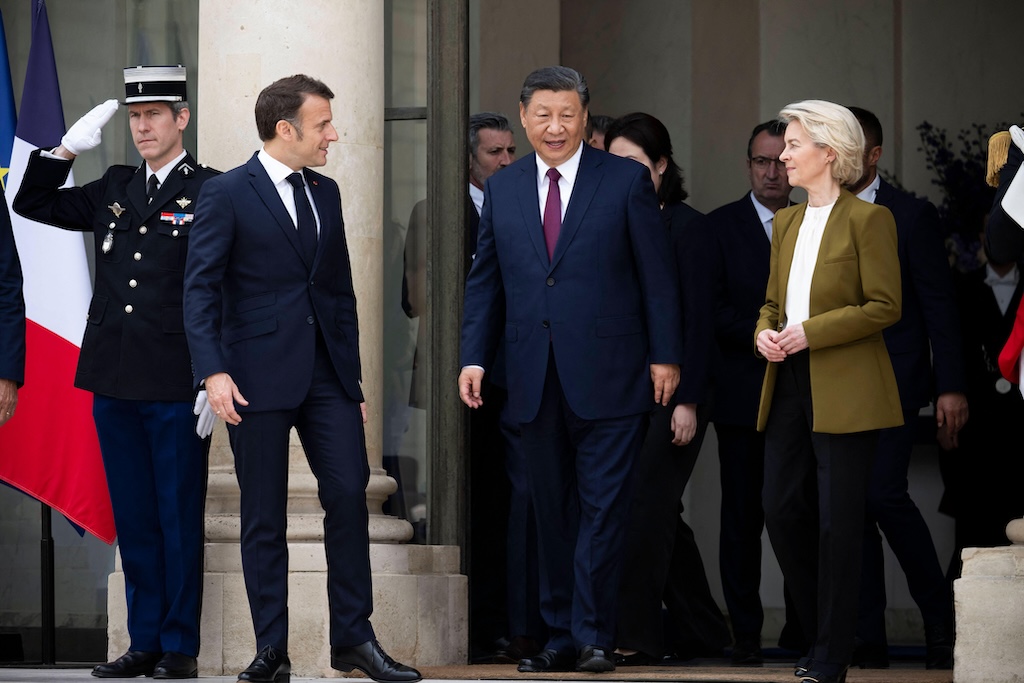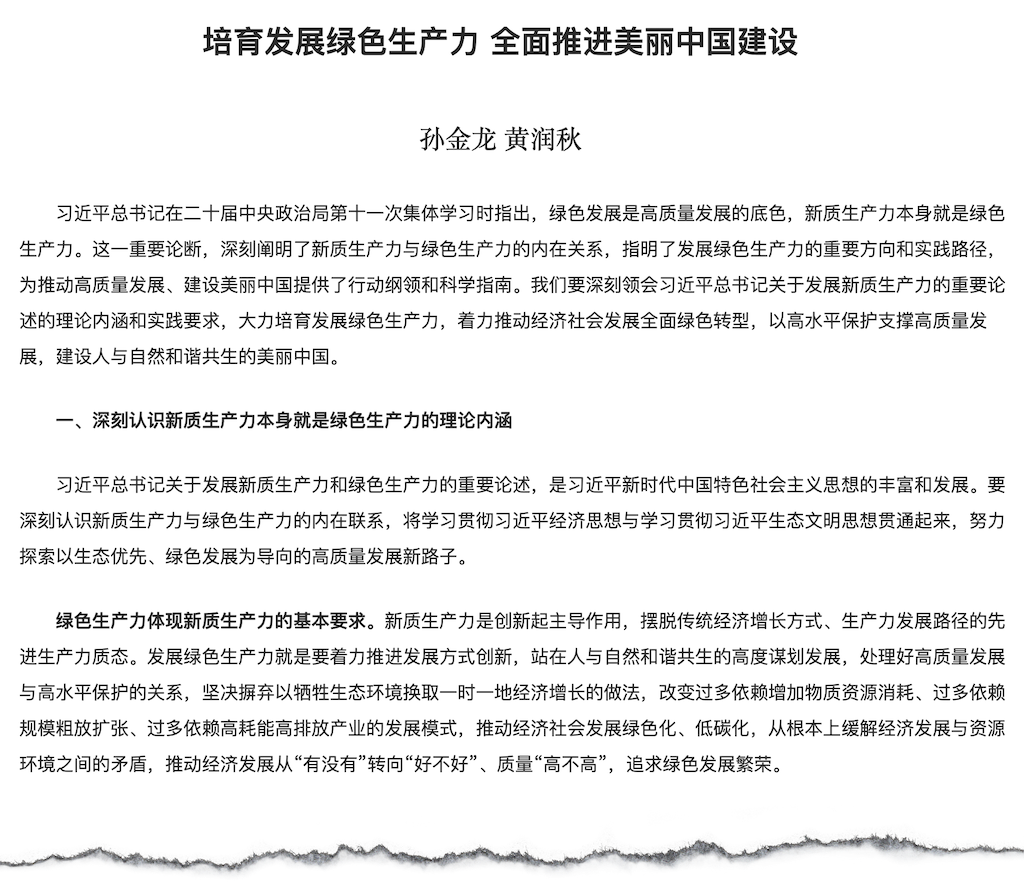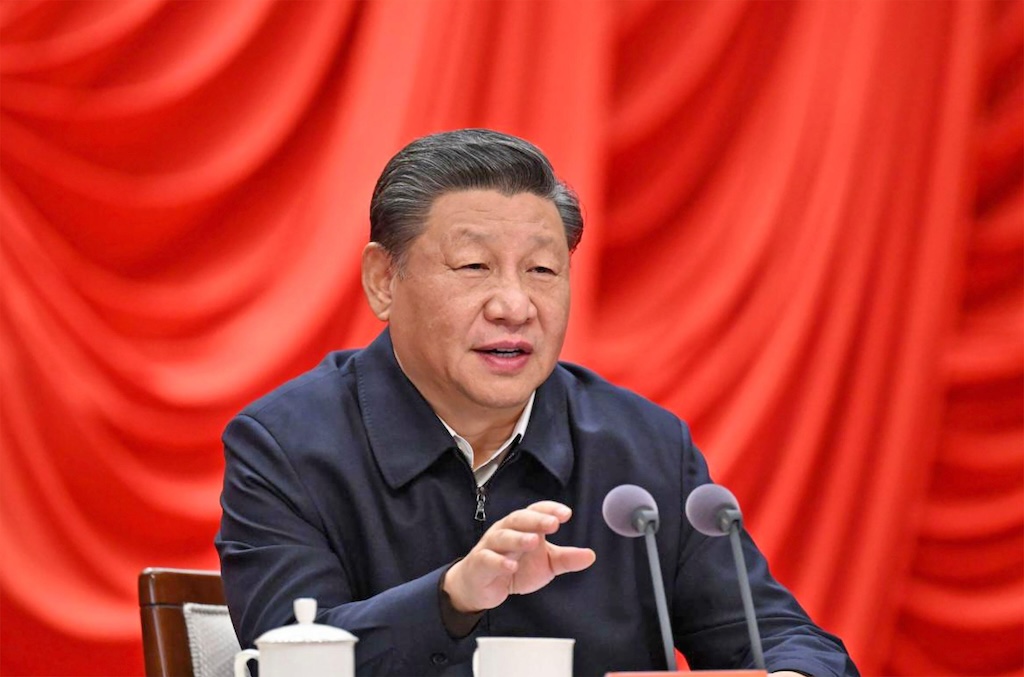China’s Third Plenum, an important five-yearly meeting traditionally associated with major economic reforms, concluded on 18 July in Beijing.
Observers have been eagerly anticipating signals from the meeting about the leadership’s plans for economic growth and wider development, including on climate action.
The official readout from the meeting of the Central Committee of the Chinese Communist Party calls on policymakers to pursue a range of relevant reforms.
These include a focus on “high-quality economic development” (高质量发展), as well as “supporting all-around innovation” (支持全面创新) and “deepening reform in ecological conservation systems” (深化生态文明体制改革), among other areas.
It also urges officials to “make concerted efforts to cut carbon emissions” and “actively respond to climate change”. This is the first time carbon emissions have been mentioned in a plenum document.
A key step to achieve this, it adds, is through “improving institutional mechanisms for developing new quality productive forces” (NQPF, 新质生产力).
Since its first appearance in official rhetoric in September last year, this term has featured in Chinese state media in numerous high-level policy documents and commentaries about industrial development and low-carbon growth.
According to Chinese president Xi Jinping, one important element of NQPF is “green development”, which he has described as the “base colour of high-quality development”. In comments made in January 2024, he added that “new quality productivity itself is green productivity” (新质生产力本身就是绿色生产力).
This encapsulates both the development of low-carbon technologies, such as electric vehicles (EVs), and the “green transformation” of the economy.
However, there is significant debate as to whether the concept, which can also be translated as “new productive forces” or “new quality productivity”, will result in concrete policy outcomes and support further development of industries critical to China’s energy transition.
In this article, Carbon Brief unpacks the concepts underpinning new quality productive forces, and what it means for China’s climate, energy and industrial policy.
What does ‘new quality productive forces’ mean?
The phrase was first mentioned by Xi during a visit to Heilongjiang province, located in the “rust belt” of northeast China, in 2023.
In January 2024, he further defined it as innovation-led development that creates “a break with traditional economic growth models and development pathways”, resulting in a “high level of technology, efficiency and quality” (高科技、高效能、高质量) as well as an “in-depth transformation and upgrading of industry” (产业深度转型升级).
This has led to a “ubiquitous” focus on innovation across official discussions about NQPF, according to the University of Cambridge-affiliated thinktank Cambridge Industrial Innovation Policy.
Unleashing this innovation, according to official interpretations, will lead to a cascade of changes across China’s industrial system – “both technological and institutional” – that will improve China’s advanced manufacturing capabilities.
Nevertheless, innovation and advanced technology are not the only focus. Analysis by the Council on Geostrategy says the framing of NQPF “suggests that, while scientific and technological innovation is essential, [China recognises there] needs also to be deeper reforms of the…economic model”.
Priority areas for reform include the market-based economy; state owned enterprises (SOE); and China’s fiscal, household registration and healthcare systems.
These economic reforms, driven both by “the government’s ‘visible hand’ and the market’s ‘invisible hand’”, are necessary for China’s continuous prosperity, according to the Xinhua Institute, a thinktank affiliated with state news agency Xinhua.
The institute links NQPF with Marxism, arguing this is in line with improving “means of production” – an important force in Marxist theory for production, reform and human development.
Most official explanations of the concept are relatively broad and unspecific. However, low-carbon development is one of the few named priorities.
Back to top
How significant is this for low-carbon development?
NQPF will provide an “important support for green development”, according to a commentary in the Communist party-affiliated People’s Daily, which was reposted on the website of China’s National Energy Administration.
“Protecting the ecological environment is to protect productivity and improving the ecological environment is to develop productivity,” it adds.
Some analysis takes this further. Prof Zhang Yunfei, from the Marxism studies department at Renmin University in Beijing and researcher at its National Institute of Development and Strategy, tells the government-affiliated newspaper China Environment News that NQPF represents a development model specific to China.
This contrasts with “traditional productive forces in Western societies”, or “black productivity” (黑色生产力), which saw “high consumption of resources and energy, and high pollution of the ecological environment”, he says.
Instead, NQPF signifies “green productivity”, which will help China “shift from conforming to leading globalisation, and promote the country’s healthy and green development”.
“Green productivity”, Zhang adds, is sustainable productivity that focuses both on increasingly productive “ecologicalisation” (生态化) and increasingly ecological productive forces driving wider development.
These forces are fundamentally provided by and rooted in nature, he explains. Driving forces include “sustainable resources such as information”, a “new generation of workers” that understand the concept of ecological civilisation and an enhanced “level of sustainable development” based on “green science and technology”.
Back to top
Why is the concept important?
This concept of NQPF is a holistic approach “designed to address complex, interrelated challenges faced by China and to create a more resilient and dynamic economy that will bring long-term prosperity”, Dr Muyi Yang, senior electricity policy analyst for China from the thinktank Ember, tells Carbon Brief.
Arthur Kroeber, founding partner and head of research at research firm Gavekal Dragonomics, tells Carbon Brief that NQPF is “the latest iteration of a long-running trend towards industrial policy, technology and intensive growth”.
This is “essentially a new bottle for old wine”, Kroeber adds. “I think what it does do is emphasise the point that there is a national mission” to build China into a technological superpower.
“It is a big deal”, Bill Bishop, author of the Sinocism newsletter, told Bloomberg, as Xi “putting a stamp” on the idea will “send a powerful signal” to stakeholders across the system.
The idea addresses specific anxieties facing China’s leadership. As well as supporting economic growth, some argue that strengthening the country’s ability to innovate provides China with a greater sense of security.

According to the Chinese Communist party’s leading theoretical journal Qiushi, for example, Xi believes that China is “still reliant on others for some core technologies…our industry is still not strong enough in spite of its size and falls short of excellence…and we face significant pressure in making the transition to green and low-carbon production modes”.
Prof Yao Yang, liberal arts chair professor at the China Center for Economic Research and the National School of Development at Peking University in Beijing, echoes this, writing in a comment for China Daily that the “significance” of the concept is the overarching aim of “laying a solid foundation for the future of the Chinese economy”.
Kroeber tells Carbon Brief that this is also driven, in part, by historical parallels between China’s fear of being cut off from US technological advancements and the rupture with the Soviet Union in the Mao era. He says:
“After the Sino-Soviet split, Soviet advisors who went [to China] to help build steel plants and develop the petrochemical industry, for example, all left. China was left [to develop its economy] on its own…Xi Jinping has drawn a specific connection [to that].”
Back to top
What does this mean for China’s low-carbon technology industries?
A primary aim of NQPF is to expand “strategic emerging industries” and “nurture future industries”, Deng Zhou, associate research fellow at the Institute of Industrial Economics of the Chinese Academy of Social Sciences, writes in the state-run newspaper China Daily.
“Strategic industries” include “new energy”, “new energy vehicles” and “energy conservation and environmental protection”. Recent analysis for Carbon Brief found that “clean energy” sectors contributed 11.4tn yuan ($1.6tn) to China’s economy in 2023.
“Future industries”, according to a policy document issued in January, include nuclear energy, nuclear fusion, hydrogen, biomass, crystalline silicon solar cells, thin-film solar cells and new energy storage such as batteries, among other areas.
These are “implied to be the major sectoral targets” for the NQPF, according to Kroeber.
In his January speech, Xi said that successful deployment of NQPF requires “accelerating green science and technology innovation…promoting application of advanced green technology…strengthening the green manufacturing industry…growing the green energy industry…[and] developing green and low-carbon industrial and supply chains”.
Much of this will be driven by state-coordinated efforts. China Daily says that efforts to cultivate NQPF “will encourage its centrally administered state-owned enterprises [SOEs] to deploy more resources toward developing strategic emerging industries”.
Kroeber believes that this will lead to “national resources [being] mobilised through a ‘new national system’ (新型举国体制)”.
He tells Carbon Brief that the system is an attempt to “create better coordination mechanisms” between the central and local governments in order to better achieve policy goals, such as through research consortiums focused on technological innovations.
This is inspired by the success of China’s electric vehicle (EV) industry, which benefited both from significant state support and from the emergence of innovative and intensely competitive businesses.
Several commentaries and articles highlight EVs as a key example of NQPF working in practice.
Wang Yiming, vice chairman of the China Center for International Economic Exchanges and former vice minister of the Development Research Center of the State Council, wrote in the state-sponsored Guangming Daily that “the rapid development of China’s EVs is a vivid case of NQPF, formed by the deep transformation and upgrading of industry”.
Using innovation to foster leading expertise across different industries, China hopes, will allow the country to replicate its achievements in the EV sector in other industries.
For example, a blog post on Yuyuan Tantian, a WeChat account affiliated with state broadcaster CCTV, draws a link between China’s experience in manufacturing LCD televisions and its later success in developing solar technologies, which require similar manufacturing technologies and processes.
Prof Zhang tells China Environment News:
“New quality productive forces are not simply a process of transformation from old productivity to new productivity…It is a qualitative leap in productivity based on the achievements of the new round of scientific and technological revolution and industrial transformation, which is characterised by green, intelligent and ubiquitous (绿色、智能、泛在) trends.”
Back to top
What are the concerns over NQPF?
China’s use of state resources to support strategically important industries, such as EVs, has recently fuelled anxieties about “overcapacity” in some countries.
Both the US and the EU have imposed tariffs on China-made EV imports. The EU’s tariff rate for individual automakers is based on the amount of state subsidies, including R&D grants, that the bloc determined those companies to have received.
There are also concerns around overcapacity domestically. A March Reuters article quoted an anonymous Chinese policy adviser saying: “The direction of promoting tech innovation is right, but my worry is how to achieve it – what path and what institutional mechanisms should we rely on?”
To a point, these concerns are also shared by the leadership. In an article translated by the Pekingology newsletter, Han Wenxiu, a top economic policy planner, cautioned against “campaign-style” implementation of NQPF policies that lead to “neglecting or abandoning traditional industries”, as well as “blind conformity and bubbles”.
Some analysts have linked NQPF to a broader push for faster economic growth and challenges tackling “deep-seated difficulties” in economic reform, which has led to a “lack of more radical action on consumption”.
Michael Pettis, senior fellow at the Carnegie Endowment, is quoted by the Financial Times saying that “the exit strategy has to be, at the end of the day, consumption – there’s no point producing all this stuff if no one’s going to buy it”.
But given current tensions with the US, Kroeber tells Carbon Brief, China “can’t rely on imports of technology in the same way…It must have an all-of-nation effort to develop its own alternatives for the technologies it used to import.”

In his view, efforts to foster NQPF “could” lead to the creation of more capacity – although he finds concerns around overcapacity to be overly “politicised”.
He says that any spikes in capacity may be “unintentional” as “the Europeans and Chinese are actually starting discussions on [resolving concerns around] EVs”.
Yang tells Carbon Brief that “innovative technologies are often not commercially viable and struggle to compete with mature technologies in the market”, highlighting the need for government support to make the EV industry viable. He adds:
“The world needs to achieve rapid and deep decarbonisation within a very short timeframe. The market often drives incremental change. But what is required now is more radical, fundamental change.”
Back to top
Will NQPF translate into concrete climate policy?
At a press conference on 24 June, the Ministry of Ecology and Environment (MEE) announced that it will release a ‘1+N’ policy on NQPF, which will “promote the accelerated development of NQPF” and “thicken” the “green-ness” of high-quality development (厚植高质量发展的绿色底色).
This followed an article in Qiushi by MEE minister Huang Runqiu and party secretary Sun Jinlong, who wrote that “ecology is itself the economy – if you protect ecology, ecology will give you returns”.
The ‘1+N’ framework is well-established in Chinese environmental policymaking, forming the basis for China’s climate policy.
It refers to “1” policy setting overarching objectives, which guides numerous (“N”) action plans and policy measures that include more concrete targets.
The MEE said that NQPF “can help promote the significant decline of pollutants and carbon emissions, and radically improve the quality of the ecological environment”.

On 11 July, it released one of the first “N” policies in the system – regulations to update “management of ecological environment zoning control”.
Analysis by consulting firm Trivium China questions whether this “will directly contribute” to development of NQPF, but adds that it could signal the MEE “leveraging” the concept to “push through reforms that might otherwise be stymied” by other stakeholders.
Meanwhile, the Ministry of Science and Technology (MOST) announced on 17 July that it will establish a centre for promoting NQPF. This may improve MOST’s “autonomy” in policy planning for science and technology innovation, an analyst told finance newspaper 21st Century Business Herald.
Kroeber says that “every document the government comes out with now has to have some reference to NQPF. It’s just a way for bureaucrats to say ‘we have heard the signal [from Beijing] and we are pursuing [those goals]’”.
He adds that one area in which China may issue more concrete policies is power market reform.
China has been trying to “introduce more competition” into its power market to address a range of challenges inherent to the old grid system, including increasing the share of renewable power in overall power generation.
It is “an area where this idea of coordination and the state playing a more leading role in getting everyone to move together” is crucial, Kroeber says, given the importance of access to abundant, low-cost electricity to power development of more technology.
Seeing further progress “would be the litmus test of whether the government is pursuing its aims [around NQPF] in an effective way”, he adds.
However, Yang tells Carbon Brief that while NQPF “has theoretical underpinnings, it is far from being purely conceptual”.
He says: “I believe more actions in various sectors will come soon to translate it into concrete initiatives and programs.”
Sharelines from this story

















.png)


Discussion about this post